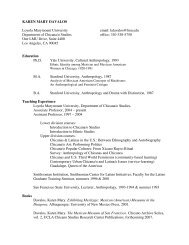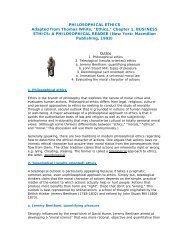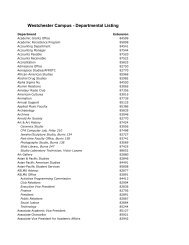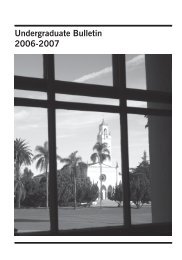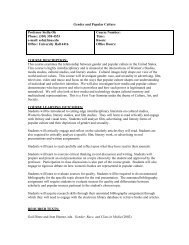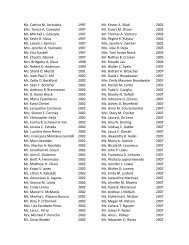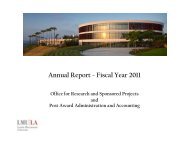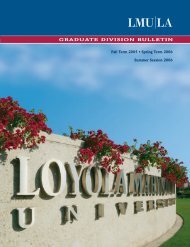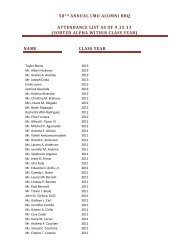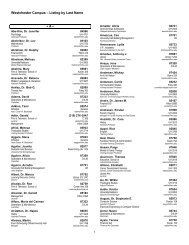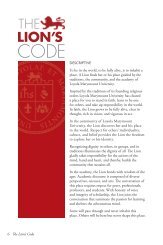October 4, 2012 - Loyola Marymount University
October 4, 2012 - Loyola Marymount University
October 4, 2012 - Loyola Marymount University
Create successful ePaper yourself
Turn your PDF publications into a flip-book with our unique Google optimized e-Paper software.
Faculty Senate<br />
Collins Center<br />
<strong>October</strong> 4, <strong>2012</strong><br />
Present: Franca Dell’Olio, Andrew Dilts, Véronique Flambard-Weisbart, Richard Fox, Paul Harris Jamie<br />
Hazlitt, George Hess, Mladen Milicevic, Katherine Noon, Patricia Oliver, John Parrish, Ralph Quinones<br />
Robert Rovetti, Marta Sanchez, Sue Scheibler, Tim Shanahan, Carl Urbinati, Thomas White and Amy<br />
Woodson-Boulton.<br />
Excused: Hawley Almstedt, Laurel Burks, Elizabeth Drummond, Omar Es-Said, Michele Hammers, Diane<br />
Meyer and Jennifer Pate.<br />
Moment of Silence<br />
President John Parrish welcomed the two newly elected senators Ralph Quinones from the<br />
College of Business Administration and Marta Sanchez from the School of Education.<br />
Motion 1: Approval of the September 20, <strong>2012</strong> minutes. By unanimous consent the acronym “APRC”<br />
was corrected on page one.<br />
15 for, 0 against, 2 abstentions<br />
Staff Senate President Nick Mattos has suggested coordinating a Faculty and Staff Senate social<br />
event. The idea was accepted by the senate and Jamie Hazlitt and Sue Scheibler volunteered to<br />
assist with coordinating the event.<br />
Paul Harris volunteered to assist with the 2013 Faculty BBQ.<br />
The LMU Economic Model<br />
Guest: Joe Hellige, Provost<br />
Provost Joe Hellige joined the senate to discuss the LMU economic model. He began by<br />
outlining where university revenue comes from and where it is allocated. As a private<br />
university, approximately 81%-82% of revenue comes from tuition dollars. Approximately 11%<br />
comes from auxiliary services, 5% from investment income, and 3% from current gifts, which are<br />
often restricted for a specific purpose. Many private university budgets depend considerably<br />
more on their endowment than we do at LMU.<br />
The breakdown of tuition dollars is approximately 70% from undergraduate students, 18% from<br />
<strong>Loyola</strong> Law School, 11% graduate students on Westchester campus and 1% from LMU<br />
extension. With respect to expenditures, approximately 50% is spent on faculty/staff<br />
compensation (salary and fringe benefits) and 21% is allocated for financial aid for<br />
undergraduate and graduate students. Operating expense is approximately15% of the budget,<br />
9% is for auxiliary expenses, 4% for depreciation (on such things as buildings and equipment)<br />
and 1% for interest on loans. LMU currently has approximately 377 million dollars of<br />
endowment and the annual payout is approximately 5%. The annual operating budget is<br />
between 350-400 million dollars.
Discussion<br />
Q. I have heard the phrase Graduate Programs have been said to pay for themselves. Is this<br />
accurate?<br />
A. When you have departments providing both undergraduate and graduate degrees, it makes<br />
it difficult to determine the breakdown. The School of Education is unique and has a model<br />
where its graduate programs must pay for their operations.<br />
Q. You mentioned an analysis that held all revenue constant for a year and that attempted to<br />
hold all expenses constant for a year. The result was estimated to be a 4.7 million dollar deficit<br />
in year one, with a 16 million dollar deficit after 3 years. Why is this?<br />
A. One of the largest reasons was a projected 1.5 million dollar adjustment for the cost of<br />
benefits, largely attributable to a projected increase in health care costs.<br />
Approximately 300,000 dollars is allocated annually for promotions and faculty advancement to<br />
tenure. Additionally, 1.5 million is provided in financial aid to cover the difference between the<br />
aid provided to graduating seniors and the cost of providing the same percentage of aid to the<br />
incoming first-year students. Approximately 500,000 dollars is project to be utilized for<br />
previously approved capital projects.<br />
We are currently in an environment where LMU will not be able to raise tuition more than<br />
3%. LMU has a balanced budget; however the institution is not in a position to continue<br />
drastically increasing tuition. LMU tuition has increased 82% in 10 years. The commitment to<br />
small class sizes and an emphasis on whole person education will always be expensive.<br />
LMU was ranked as one of the 10 most expensive universities by the Department of Education’s<br />
net price calculator. This looks at the price of attendance minus money given back in financial<br />
aid. LMU is ranked 8 th in cost of tuition within the 28 Jesuit universities. The most recent<br />
undergraduate application pool was growing at just under 12,000 applicants, with close to 50%<br />
being admitted.<br />
New Scholarship Initiative<br />
Guest: Dennis Slon, Senior Vice President of <strong>University</strong> Relations<br />
The new scholarship initiative will serve as a bridge from the last capital campaign and will be<br />
announced at the President’s <strong>2012</strong> Convocation. The President moving forward has indicated<br />
his focus on building the endowment and on people. This effort will be a major scholarship<br />
initiative focused on scholarships for undergraduate and graduate students. It will be a shortterm<br />
(3 year) concentrated effort with a goal of 100 million dollars. Approximately $65 million<br />
will be allocated for the endowment and $35 million for current use. There are currently other<br />
fundraising efforts for a variety of projects including the new life science building.
Affinity groups comprised the majority of donors in the previous campaign and a majority of the<br />
money raised was (96%) restricted. Unrestricted support was around 4%. These donors have an<br />
affinity for departments/schools, underrepresented populations and high academic achievers.<br />
The next comprehensive campaign will come out of strategic planning discussions. The New<br />
Scholarship Initiative will be raising money both for undergraduate and graduate<br />
scholarships. The breakdown will be $75 million for undergraduate and $25 million graduate.<br />
Discussion<br />
Q. There is some concern about a focus on building the endowment during turbulent economic<br />
times. What is the rationale for this focus?<br />
A. There is a sense that the endowment could weather economic downturns and that building<br />
the endowment is more practical than consistently increasing tuition.<br />
Q. I understand the time intensive work that goes into the campaign. I would like to know how<br />
the case statement is drafted and if faculty input would be valued.<br />
A. The case statement is a marketing type tool drafted by a freelance writer, but we will<br />
certainly value faculty input and provide an opportunity for feedback.<br />
Beyond raising money for the endowment, ensuring students can come here; supporting faculty<br />
work, travel, and research will be the next big fundraising components.<br />
Currently around 40% of lower division classes are taught by part time faculty. We need to look<br />
at this as a priority and determine what needs to be taught with less part time faculty.<br />
The President and Provost will discuss areas facing higher education and touch on many of these<br />
related topics at their respective convocations.<br />
WASC Accreditation<br />
Guests: Shane Martin, Dean of the School of Education<br />
Margaret Kasimatis, Associate Provost for Strategic Planning and Educational Effectiveness<br />
WASC is a voluntary, peer- review process that evaluates the university as a whole. The new<br />
review process has been streamlined and now composes of one self-study report and one visit.<br />
LMU must submit the self-study report in July 2013 and has begun to focus on the campus visit<br />
scheduled for the Spring of 2014.<br />
The WASC Steering Committee is populated by LMU faculty and administrators. The group is<br />
currently identifying gaps in meeting the standards and progress from the last WASC special<br />
visit, gathering documentation and developing the “story” to be told for the self-study. The four<br />
categories of focus from the special visit are; assessment of student learning, outcomes-based<br />
curriculum design, strengthening and aligning planning processes, and ownership and<br />
infrastructure for organizational learning. WASC believes strongly in a culture of evidence and is<br />
looking at how the gaps and weaknesses are being addressed.
There are five components of the self-study which will be presented in the form of five essays.<br />
These sections are the introduction, the body of the report, an optional essay on institutional<br />
specific theme, an integrative essay and an electronic exhibit portfolio. The steering committee<br />
is working on the essays, but needs to engage more faculty in this conversation. The body of the<br />
report will address the following areas:<br />
o Defining the meaning of LMU degrees and ensuring their integrity, quality and rigor.<br />
o Achieving “core competencies”<br />
o Defining and promoting “student success”<br />
o Ensuring institutional capacity and effectiveness in the future, and planning for the<br />
changing environment for higher education.<br />
If the fourth essay is presented well, WASC may not need to revisit LMU for 10 years. LMU has<br />
made good progress in the area of academic program review and the alignment of planning and<br />
data has assisted with the processes in place. The WASC standards below serve as guiding<br />
criteria/guidelines:<br />
Discussion<br />
o Defining Institutional Purposed and Ensuring Educational Objectives.<br />
o Achieving Educational Objectives through Core Functions<br />
o Developing and Applying Resources and Organizational Structures to Ensure<br />
Sustainability<br />
o Creating an Organization Committed to Learning and Improvement<br />
Academic technology is important to LMU achieving its learning outcomes. The current process<br />
in place is sending out a survey on the satisfaction of academic technology. We need to look at<br />
peer institutions to make this process more robust and know how this impacts student learning.<br />
I feel we need to strengthen the language that LMU is a comprehensive liberal arts college. We<br />
are operating in an environment in which liberal arts is not highly valued.<br />
The essay on defining the meaning of LMU degrees and ensuring their integrity, quality and rigor<br />
relates to our discussion on transitioning to 4-unit courses. An increased ability to be self-critical<br />
is difficult, yet critical for students.<br />
There are two distinct questions; what a student has to do to earn a degree and what sort of<br />
person should they be when handed the degree.<br />
Adjourned at 5:02pm<br />
Submitted by: Franca Dell’Olio<br />
Prepared by: Robert Houghtaling



